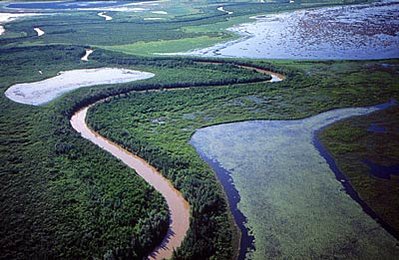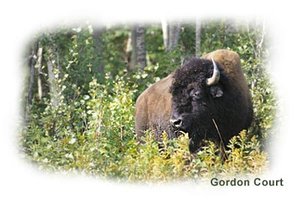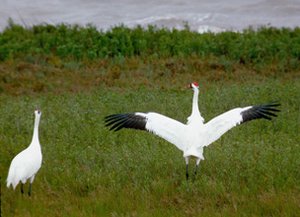Wood Buffalo National Park, Canada
| Topics: |
Contents
- 1 IntroductionWood Buffalo National Park (58°00'-60°40'N, 111°00'-115°30'W) is a World Heritage Site located in Canada. (Wood Buffalo National Park, Canada)
- 2 Geographical location
- 3 Date and history of establishment
- 4 Area
- 5 Land tenure
- 6 Altitude
- 7 Physical features
- 8 Climate
- 9 Vegetation
- 10 Fauna
- 11 Cultural heritage
- 12 Local human population
- 13 Visitors and visitor facilities
- 14 Scientific research and facilities
- 15 Conservation value
- 16 Conservation management
- 17 IUCN management category
- 18 Further reading
IntroductionWood Buffalo National Park (58°00'-60°40'N, 111°00'-115°30'W) is a World Heritage Site located in Canada. (Wood Buffalo National Park, Canada)
Geographical location
On the state boundary between Alberta and Northwest Territories. 58°00'-60°40'N, 111°00'-115°30'W
Date and history of establishment
Wood Buffalo was declared a national park in 1922 (as 2,600,000 hectares (ha)), and expanded in 1926 to its current size. The park includes all except 230,000 ha of the Whooping Crane Summer Range, and the Peace-Athabasca Delta (Wood Buffalo National Park section), both of which were designated as Wetlands of International Importance under the Ramsar Convention in May 1982. Wood Buffalo National Park was inscribed on the World Heritage List in 1983.
Area
 Wood Buffalo National Park, a World Heritage Site Photographed by C. Wallis. (Source: EoE)
Wood Buffalo National Park, a World Heritage Site Photographed by C. Wallis. (Source: EoE) 4,480,000 ha.
Land tenure
Government of Canada.
Altitude
Ranges from 217 meters (m) to 945 m.
Physical features
Comprises a vast wilderness area of the Northern Boreal Plains with four main topographic features: glacially eroded plateau; glaciated plains; a major freshwater delta formed by three major rivers; and alluvial river lowlands. The lowlands and floodplains of Peace, Athabasca and Slave Rivers and the delta in Lake Athabasca exhibit classic fluvial land forms, with a complex series of meander scars, oxbow lakes and former river terraces, and good examples of birds-foot delta development. Saline plains with evaporates and extensive karstic topography are also represented on Slave River lowland. During dry periods, the mudflats of one plain are dominated by mineral salts, these salt plains being unique in Canada. Slave River Plain is well-drained through porous bedrock, and exhibits sinkholes, sunken valleys, caves, submerged rivers, classic small anticlines and a complex recharge-discharge hydrology featuring swallow holes and cold springs, some with mineralized water. Buffalo-Lake Robertson Plain is underlain by impervious shale and discontinuous permafrost, resulting in vast areas of muskeg with shallow lakes and meandering creeks. The uplands of Birch and Caribou plateau have been eroded by rivers to form long, incised gorges with long stratigraphic cross-sections of bedrock and large alluvial fans. Geologically the area has a thin Palaeozoic sequence of Middle and Upper Devonian rocks, with the east boundary of the park almost coincident with the Precambrian Canadian Shield/Palaeozoic contact along Athabasca and Slave Rivers. The plateau is of Lower and Upper Cretaceous age. Gypsum and anhydrite are abundant and minor amounts of salt, potash and limestone occur. Glacial deposits cover much of the area.
Climate
The climate is boreal continental with long cold winters and short warm summers. Temperatures range from daily means of -25°C (January) to 16°C (July). Annual precipitation is about 310 millimeters (mm), but annual evaporation is 410 mm. This moisture deficit, coupled with an average 40 thunderstorms per season, puts the park in an extreme forest fire weather zone. The brief frost-free period extends from early June to early September but much of the park is permanently underlain by discontinuous permafrost. Winter daylight period is short, while midsummer daylight period is over 20 hours.
Vegetation
Vegetation is typical of the boreal forest zone with white spruce Picea glauca, black spruce P. mariana, jack pine Pinus banksiana and tamarack Larix laricana predominant. Many watercourses have stands of balsam poplar Populus balsamifera and some uplands have nearly pure stands of aspen P. tremuloides. Extensive stands of white spruce forests cover the banks of Peace, Athabasca and Birch Rivers. Lodgepole pine Pinus contorta var. latifolia occurs along the slopes of the Cretaceous plateau on the western edge of the park. The upper surface of the plateau is about 1,500 m above the rest of the park and supports a spruce-willow-birch upland tundra community. Some areas of prairie occur, with dominant grass species being Calamagrostis canadensis, Deschampsia caespitosa, Poa spp. and Carex spp., and the Peace-Athabasca Delta has flats with marshes of cat-tail Typha latifolia and sedges Carex rostrata, C. atheroides and C. aquatilis. Shrublands of willow Salix spp. and alder Alnus sp. occur where wet marsh soils meet drier forest soils. There is also extensive muskeg in the west and north of the park, an association of black spruce, sphagnum moss and northern heath plants. The park contains the largest undisturbed grass and [[]sedge]] meadows in North America. About 1% of the park burns each year, about average for boreal forests in this part of Canada.
Fauna
 North American Bison. (Source: Sustainable Resource Development)
North American Bison. (Source: Sustainable Resource Development) The park was created specifically to protect North American bison, one of the largest free-roaming, self-regulating herds in existence, and consisting of a cross between 'wood' bison Bison bison athabascae and 'plains' bison Bison bison bison. The herd numbered 10,000 in early 1970s, declined to about 4,500 in 1987, and currently numbers some 2,500 in the Wood Buffalo National Park greater ecosystem. This is one of a the few sites where the predator-prey relationship between wolves and bison still exists. A total of 46 other mammal species have been recorded including black bear Ursus americanus, woodland caribou Rangifer tarandus caribou, Arctic fox Alopex lagopus, moose Alces alces, grey wolf Canis lupus (V), lynx Lynx canadensis, snowshoe hare Lepus americanus, muskrat Ondatra zibethica, beaver Castor canadensis and mink Mustela vison. Occasionally animals more common to southern Canada are seen, such as red fox Vulpes vulpes, porcupine Erithizon dorsatum and white-tailed deer Odocoileus virginianus. The caves of karstlands provide essential hibernation sites for bats.
A total of 227 bird species have been recorded (including species characteristic of all boreal forest habitats) which include great grey owl Strix nebulosa and snowy owl Nyctea scandiaca, willow ptarmigan Lagopus lagopus, redpoll Acanthis spp., crossbill Lorix spp. and borealchickadee Parus hudsonicus. This is the only breeding site of whooping crane Grus americana (E), with 40 breeding pairs out of 140 individuals which summer in the park. Protection and intensive management of this species in the park (and protection of their wintering ground in Texas), may have averted their extinction. Peregrine falcon Falco peregrinus and bald eagle Haliaeetus leucocephalus also breed within the park. The Peace-Athabasca Delta is an important area for migrant waterfowl including snow geese Anser caerulescens, white-fronted geese A. albifrons and Canada geese Branta canadensis, whistling swan Cygnus columbianus, diver Gavia spp., all seven species of North American grebe (Podicipedidae) and 25 species of duck (Anatidae).
Reptiles and amphibians are severely limited in numbers, but Canadian toad, leopard frog and red-sided garter snake reach their northern limits here. Boreal chorus frog and wood frog are also found in aquatic habitats. The fish fauna has been poorly studied, although there is a wide variety of aquatic habitats. Thirty-six species have been recorded to date, four of them introduced. Preliminary information suggests that pearl dace, fathead minnow and Iowa darter may be at their northern limit. The inconnu (circumpolar species) spawns in Buffalo Lake, and the Peace-Athabasca delta is an important spawning area for goldeye and walleye. Sticklebacks found in the karst lakes lack pelvic girdles, an unique adaptation to this environment.
Cultural heritage
A series of different hunter-gatherer cultures have occupied the area continuously from about 7,000 years ago up to the present. In the 18th century there were Beaver and Slave natives. Cree and Chipewyan natives gained ascendancy and integrated with European settlers.
Local human population
The community of Garden River (population 350) is located within the park. Approximately 6,600 residents live in the three small communities of Fort Smith, Hay River and Fort Chipewyan, adjacent to the park. Approximately 600 permits are issued for hunting and trapping. Some of these individuals who hold trapping permits may reside in the park during the winter months.
Visitors and visitor facilities
6,200 people visited the park in 1994. Supplies, services and accommodation are available in the towns of Hay River and Fort Smith outside the park. There are 36 campsites within the park at Pine Lake and group camping is also available.
Scientific research and facilities
Ongoing studies include fire ecology, karst topography, whooping cranes, wetlands ecology, restoration of timber berth, and the biology and control of disease in bison. A bison movement study has just been completed.
Conservation value
 The Wood Buffalo National Park is the sole breeding place of the Whooping Crane, an internationally threatened bird. (Source: Texas Parks and Wildlife Department)
The Wood Buffalo National Park is the sole breeding place of the Whooping Crane, an internationally threatened bird. (Source: Texas Parks and Wildlife Department) Wood Buffalo National Park affords protection to the largest population of wild bison in America and is the nesting place for the internationally threatened whooping crane. It also contains the Peace-Athabasca Delta, which is the largest inland delta in the world.
Conservation management
National park policy provides comprehensive operational guidelines for the management of the park. A park management plan has been prepared as an expression of this policy, and provides guidance for park management, operations and development. A zoning plan has been defined and designates the bulk of the park as wilderness (Zone II) or special preservation (Zone I). Special preservation areas include the whooping crane nesting habitat, a bison grazing and calving area in the Peace-Athabasca Delta, examples of karst features and significant archaeological sites. A natural resource management program consisting of resource inventories, studies and preparation of resource management plans is being implemented. All proposed developments and management actions are subject to an environmental assessment and review process. Local residents are allowed to hunt and trap game, except buffalo and other endangered species (IUCN Red List Criteria for Endangered), but are subject to park regulations.
Management constraints
From 1922 until 1964, the park was not administered by the National Parks Branch, and management of the area was not oriented toward conservation but intended to help create a stable regional economy by bringing benefits to local residents. This resulted in intensive management of bison and other species. Commercial activities such as lumbering were also allowed. Plains bison moved to the park in 1925, interbred with native wood bison resulting in the hybridization of the two subspecies and the introduction of bovine tuberculosis and brucellosis. Management measures were undertaken in the 1960s and 1970s to control the diseases, and the issue of diseased bison is currently being examined by a five year $2.775 million research program.
The Peace-Athabasca Delta is drying out, causing important food sources to disappear and allowing easier access to predators. The changes are partly due to the downstream effects of the Bennett Dam constructed in 1969. Water quality in the Peace River is now being threatened by the construction of pulp mills upstream of the park, which have the potential to pollute park waters and cause ecological changes. The changing water levels have altered this internationally important waterfowl nesting area.
The park is subject to land claims by native people. One claim affecting the Peace-Athabasca Delta area was settled in 1985, another claim affecting the area north of the 60° parallel of latitude is pending. Effects of the land claim settlement have included boundary adjustments, entrenchment of resource harvesting rights and creation of advisory boards composed of local people. Land claims currently being negotiated will have similar implications for park management. Commercial logging was terminated in 1991. Sport fishing is allowed, under permit.
Staff
32 full-time employees including a resident superintendent; 43.51 person-years of employment (1994/95).
Budget
Total expenditure Can$ 838,100 (Operations and Maintenance), $1,090,362 Capital Development (1994/95 fiscal year).
IUCN management category
- II (National Park)
- Natural World Heritage Site - Criteria ii, iii, iv
Further reading
- A review of the available literature was carried out by Scace and Associates (1974, Wood Buffalo National Park - a literature review), but more recently, literature on the National Parks of Canada has been listed and indexed by the National Parks Documentation Centre, Ottawa, Ontario.
- Airphoto Analysis Associates (1979). Integrated Resources Survey, Wood Buffalo National Park.
- CNPPA Summary Status Report (1984). Threatened Protected Areas of the World (draft).
- Parks Canada (1993). Wood Buffalo National Park Management Plan. (Unseen).
- Parks Canada (1994). Park Ecosystem Conservation Plan. (Unseen).
| Disclaimer: This article is taken wholly from, or contains information that was originally published by, the United Nations Environment Programme-World Conservation Monitoring Centre (UNEP-WCMC). Topic editors and authors for the Encyclopedia of Earth may have edited its content or added new information. The use of information from the United Nations Environment Programme-World Conservation Monitoring Centre (UNEP-WCMC) should not be construed as support for or endorsement by that organization for any new information added by EoE personnel, or for any editing of the original content. |